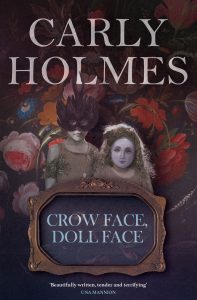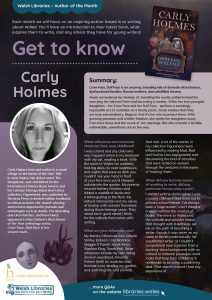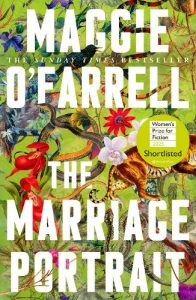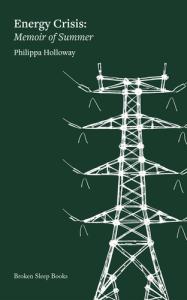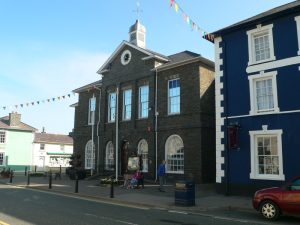Carly Holmes
December 1, 2023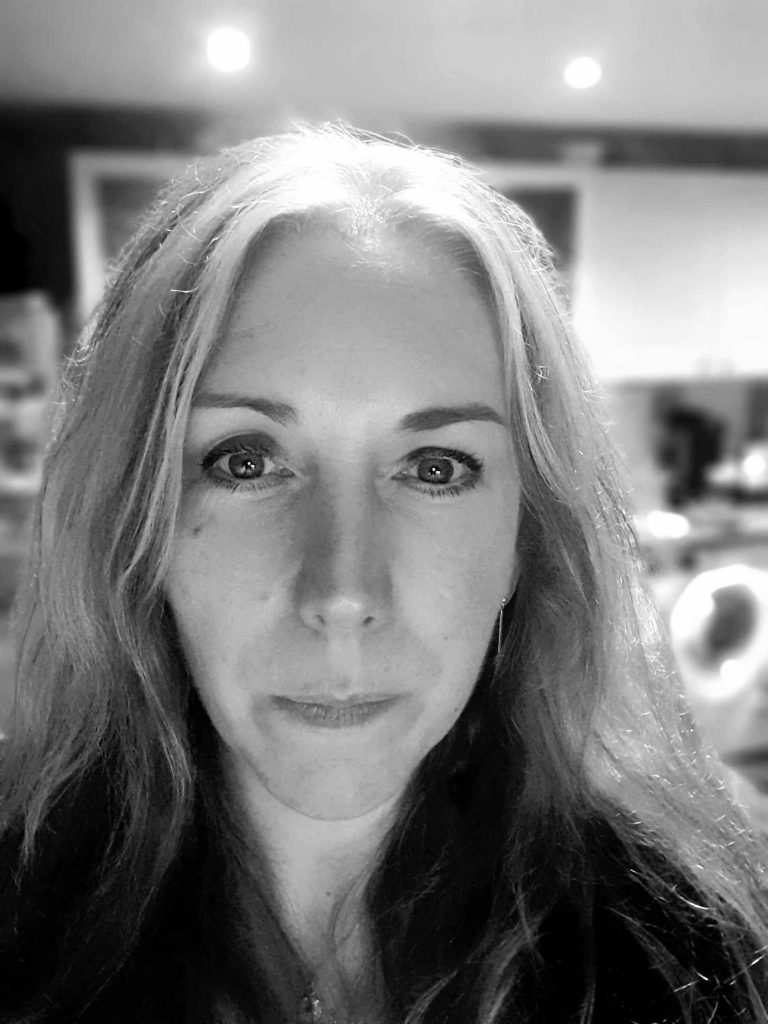
Many congratulations Carly on the publication of Crow Face, Doll Face. Tell us a little about the story, where did the inspiration come from, and what do you hope readers will take away…
Crow Face, Doll Face is my second novel and it’s about Annie, mother of four, who sacrificed her dreams of travelling the world to marry the love of her life and raise children. When her two youngest daughters – her Crow Face and her Doll Face –perform a seemingly impossible act of levitation at a family picnic, Annie realises that they are truly extraordinary and need her special protection. It can be read in two ways: as an uncanny tale of strange and magical children, or as a mother’s psychological breakdown. I have no idea where the inspiration came from but it’s about dysfunctional families and I’m always drawn to write about them. I hope readers will enjoy the story and the writing, and I also hope that the characters, in all their flawed and complex humanity, will linger after the book has ended.
Tell us a little about your background – upbringing, education…
I was born on the Channel Island of Jersey (I’m part French, part Jersey Bean on my mother’s side) and moved to England when I was young, then to Wales when I was eleven. We lived in a small cottage near Pontsian in Ceredigion. It was a total change, moving from a large council estate to a remote cottage a mile from the nearest village. I went to Ysgol Gyfun Emlyn, Newcastle Emlyn, and then to UWTSD, Lampeter, to study for an English Literature degree. From there I went straight on to UWTSD, Carmarthen, to study for an MA in Creative Writing. Many years later I returned to Lampeter to do a PhD in Creative Writing. I think those adolescent years of rural living filled me with a horror of cities and being among crowds of strangers.
What influences and memories stand out from your childhood?
I was a timid and shy child who was happiest when in my bedroom with my cat, reading a book. With the move to Wales we suddenly had big skies, no near neighbours, and nights that were so dark you couldn’t see your hand in front of your face once you’d stepped outside into the garden. My parents rescued battery chickens and added a waddle of ducks and a blind gosling to the flock. Beep Beep, the gosling, grew up to be a very stroppy gander who thought I was his wife. My natural introversion and my sense of kinship with animals flourished during those teenage years. They stood me in good stead, I think, for the solitude that comes with writing.
As a young person, who or what influenced you? Music, celebrities, TV programmes, books, magazines, people in your everyday life…
I’ve been drawn to the gothic and melodramatic since I was young. Daphne du Maurier’s novels, overblown rock music (think Meat Loaf, Muse and Jim Steinman), the bats that scratched and squeaked from their roost beneath the tin roof inches from my head when I lay in bed… These were the pre-internet times so music was recorded and played on tape cassettes and the concept of celebrities as influencers hadn’t yet reached Pontsian. Our television only worked sporadically and the picture was always grainy, the characters trailing ghosts of themselves across the screen. Following a programme was often as much guesswork and using your imagination to fill in the gaps as anything else.
What are your influences now?
My literary influences now include Shirley Jackson, Una Mannion, Maggie O’Farrell, Sarah Moss, Stephen King, Sarah Hall. Other influences include my cats, being alone in woodland, Amanda Palmer (both as musician and feminist icon), tending my garden, and watching the wild animals that visit. A lot of the stories in my collection Figurehead were influenced by reading Mad, Bad and Sad by Lisa Appignanesi and discovering the kind of atrocities that were visited on women through the centuries in the name of ‘healing’ them.
What advice (if any) would you give to your younger self?
I think the most important thing I’d tell my younger self would be to be more self-protective, both in the use of my precious free time and in my person. As I get older I’m less inclined to take on the guilt and responsibility of other people’s expectations of me, to fit into their version of me. I wish someone when I was a teenager had told me that I’m good enough just as I am.
When did you become aware of wanting to write, did any particular factors play a part?
I started writing stories when I was a young child and read them out to primary school friends. I’ve always been a huge reader; I can’t imagine a world without the comfort of books. The move to Wales and the solitude and outsider status that brought with it definitely set me on the path of becoming a writer, though it was never on my radar to think I could actually ‘be’ a published writer as I couldn’t comprehend how a person from a working-class background with no cultural or material privileges could make that leap from scribbling in notebooks to securing a publishing deal. That wasn’t a world I had any experience of.
What is your writing process?
I work in publishing four days a week and that tends to spill out onto the other three days a week, so writing is something I have to force myself to find the time to do. When I was writing Crow Face, Doll Face and more recently the nature book, I worked through every weekend and some evenings for as long as it took. Deadlines help sharpen the focus as well!
What are your favourite reading genres, and what books are you reading at the moment?
I don’t really have a genre that I read more than any other, though I do tend to read far more fiction than non-fiction. I’ve just finished The Marriage Portrait by Maggie O’Farrell, which was incredible, and for my book group we’re reading Demon Copperhead by Barbara Kingsolver. Philippa Holloway’s memoir Energy Crisis which I finished recently was fascinating. When I’m feeling low or unwell I’ll re-read the Dorothy L. Sayers detective novels, or Mary Stewart, or Georgette Heyer. They’re like a well-loved teddy and always bring me comfort.
What experiences of libraries have influenced you during your lifetime?
When we lived in England we visited the library in Romsey regularly to check out books. My parents couldn’t keep up with the amount I read! Our council estate wasn’t in a town so I never got the opportunity to just wander into a library and spend hours alone with the books; the visits had to be planned.
When we moved to Pontsian we travelled to Llandysul, several miles away, to visit the library there, and again that had to be planned. For me, libraries became something elusive and yearned for, my reliance on adults and their ability to drive dictating when and whether I could go.
As an adult, when I moved to Aberarth I wanted to find out more about the local history of the area so I went into Aberaeron library (which was open a couple of half days a week, I think!) and had lovely conversations with the librarian while I read through articles and books. It was in Aberaeron library that I found out that the ruined cottage deep in Aberarth woods that intrigued me so much had belonged to a witch many years before. Shunned by the villagers, she made her home among the trees and far away from her fellow humans.
What suggestions do you have to encourage children and young people to read more for pleasure?
Comic books and graphic novels would be a good place for young people and children to start loving words alongside pictures that work together to tell stories about their interests. Less screen time as well is vital. It must be so hard for parents these days to encourage their child to read books when the distractions and easy stimulation of the internet and social media are right there on your screen and in your home.
Are there any plans for future titles?
I’ve just finished writing a nature memoir about my encounters (and missed encounters!) with the wild creatures who live around here. There are ‘garden-based’ chapters about nurturing a frail jackdaw or spending time with a young vixen who used to visit me, and ‘beyond the garden wall’ chapters about hearing a nightjar for the first time or besotting over the juvenile osprey who stayed on the Teifi estuary last autumn for seven weeks while she learned to fish. It’s a total departure for me to write non-fiction, and I hope to see it in print one day. It was fun to write, and I found it a lot easier than writing fiction!
Crow Face, Doll Face was published 12 October by Honno.
Read our Get to Know the Author flyer and take a look at our previous Authors of the Month writing in English.

